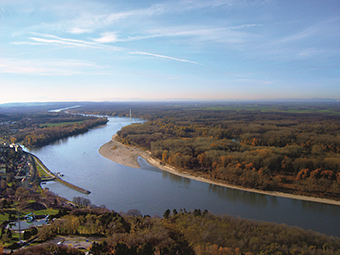Nine countries, stretching from the Black Forest to the Black Sea, have joined forces in a project to restore sediment balance in the River Danube. The work is a priority for the Danube region because, over the past few decades, human activity on the river and its tributaries has led to dramatic changes in sediment load. These changes have a negative influence on water management issues such as flood risk, inland navigation, river ecology and hydropower production.
Restoring the Danube’s sediment balance
- 29 May 2019
We look forward to the results of the Danube Sediment project, which will provide the International Commission for the Protection of the Danube River (ICPDR) with essential input for the 3rd Danube River Basin Management Plan and the 2nd Danube Flood Risk Management Plan.
Scientists and engineers from Hungary, Austria, Croatia, Romania, Bulgaria, Slovenia, Slovakia, Germany and Serbia are collaborating in the Danube Sediment project. Because the river flows through so many countries, a transnational approach was seen as the only way to effect change across the entire Danube basin.
Improving river management
The project team collected sediment transport data from along the river to allow for an accurate analysis of sediment distribution. The information is being collated into the first-ever Danube Sediment Management Guidance. This is the main project output and a document that delivers key contributions to the Third Danube River Basin Management Plan and the Second Danube Flood Risk Management Plan. Both plans are developed by the International Commission for the Protection of the Danube River.
Interested parties are kept up to date on the project’s progress through a series of workshops. The meetings allow for the exchange of good practices for things like sediment monitoring, data collection methods and the best way to upgrade or improve sediment monitoring stations.
Helping stakeholders
Those responsible for water and sediment management along the Danube can use other documents produced through the project. These include a Sediment Manual for Stakeholders, which focuses on improved sediment management for navigation, hydropower generation, flood risk and river basin management.
In addition, a Handbook on Good Practices in Sediment Monitoring provides details on issues covered in the workshops and related subjects, including where to set up a monitoring site and how to create an effective monitoring regime.
Total investment and EU funding
Total investment for the project “Danube Sediment project” is EUR 3 558 581,62 with the EU’s European Regional Development Fund contributing 2 827 421,16 EUR and the Instruments for Pre-Accession Assistance with a contribution of 197 373,19 through the “Danube” Transnational Programme for the 2014-2020 programming period. The investment falls under the priority “Environment and resource efficiency”.

